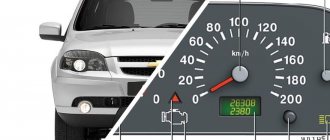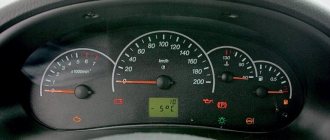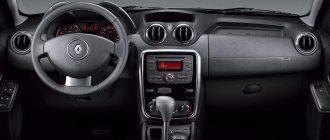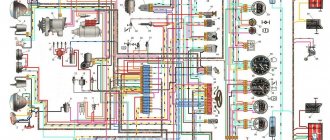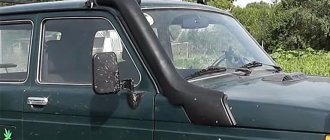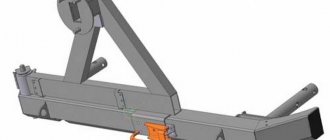Niva instrument panel: description of indicator lamps
For the fullest description, we took the shield from the most common version of the VAZ 21213.
| Number | Description |
| 3/4 | The turn indicators turn on simultaneously when the hazard warning lights are activated. |
| 7 | Insufficient fuel level in the gas tank. |
| 8 | The vehicle's side lighting is on. |
| 9 | Emergency situation in the brake system. |
| 10 | The long-range illumination of the head optics is activated. |
| 12 | Vehicle mileage monitor. |
| 13 | Check engine light. If the indicator lights up, you need to carefully check the power plant. |
| 14 | Hazard warning light. |
| 15 | Clock display. |
| 16 | If the lamp lights up, you need to check the generator and battery charging. |
| 17 | Handbrake activated |
| 18 | The engine oil level has dropped critically. |
| 19 | Most configurations include a backup lamp. |
You should also highlight the colors of the car's indicators. They can be divided into three parts.
- Green/blue – indicators of these colors indicate normal operation of machine components.
- Orange/yellow - tells the driver that a certain unit requires attention or service.
- Red is the most dangerous color. If a lamp of this color lights up on the dashboard, the car must be urgently shown to a mechanic.
Exclamation mark on the Niva panel
Indicates that the fluid level in the brake system has decreased. You will need to open the expansion tank cap and add brake fluid to the required level. It is recommended to check the line for leaks and pad wear.
Vehicle controls
The placement of controls is shown in Fig. 1-4.
- 1 – sound signal switch.
- 2 – device composition panel.
- 3 – control wheel.
On a car with a steering wheel with a built-in safety pad, to turn on the sound signals, press the steering wheel trim in the area marked with the appropriate emblem.
- 4 – shield fastening screw.
- 5 – external lighting switch.
When you press the shoulder button to the first fixed position, the side lights turn on, and to the second fixed position, additional headlights. At the same time, the lamp in the switch illuminates the button.
- 6 – heater electric fan switch.
When you press the shoulder of the key to the first fixed position, the low speed of the electric fan is turned on, and to the second fixed position - the highest speed. When the external lighting is turned on, the key illumination lamp lights up.
- 7 – windshield blower nozzles.
- 8 – central nozzles of the interior ventilation and heating system.
- 9 – control unit for the interior ventilation and heating system.
- 10 – rear window heating switch.
The heated rear window is turned on by pressing the button on the shoulder. When the external lighting is turned on, the key illumination lamp lights up.
- 11 – plug.
- 12 – switch for rear fog lights.
The fog lights turn on when the headlights are on in conditions of limited visibility (fog, snow, rain) by pressing the shoulder button. When the external lighting is turned on, the key illumination lamp lights up.
- 13 – glove box.
- 14 – nozzles for blowing glass of front doors.
- 15 – shelf for a first aid kit, magazines and newspapers.
- 16 – plug.
- 17 – plug.
- 18 – socket for installing radio equipment.
The car is equipped with the installation of radio equipment, corresponding in size to international standards (ISO 7736, DIN 7736), with its positive wire connected to the INT terminal of the ignition switch. With all this, you should keep in mind that the current consumption should not exceed 10 A, and a fuse of the appropriate rating is needed in the power supply circuit of the radio device.
- 19 – gear shift lever.
- 20 – gear shift lever in the transfer case.
- 21 – ashtray.
- 22 – key for fixing the parking brake lever.
- 23 – parking brake lever.
By moving the lever upward, the brake pads of the rear wheels are activated. To return the lever to its initial position, press key 22 and lower the lever.
- 24 – cigarette lighter.
To use, press the chuck key to a fixed position. After approximately 15 seconds, the cartridge will automatically return to its initial position, ready for use. When the device lighting is turned on, the lamp illuminates the cigarette lighter socket.
- 25 – differential lock lever in the transfer case.
- 26 – rear window cleaner and washer switch.
When you press the shoulder of the key to the first fixed position, the windshield wiper is turned on, and to the second non-fixed position, the washer is additionally turned on.
- 27 – switch lever for wipers and washers of the windshield and headlights.
- 28 – gas pedal.
- 29 – control lamp for closing the carburetor air damper.
Lights up orange when the ignition is turned on and handle 30 is pulled out.
- 30 – handle for closing the carburetor air damper.
Serves to start a cool engine. When the handle is pulled out one hundred percent, the carburetor air damper is closed; when it is recessed, it is open.
- 31 – alarm switch.
When you press the button, the blinking light of the direction indicators and the warning lamp in the button itself turns on. The alarm goes off when the key is pressed again.
- 32 – brake pedal.
- 33 – ignition switch.
- 34 – clutch pedal.
- 35 – direction indicator switch lever.
- 36 – fuse blocks.
- 37 – hood lock drive lever.
- 38 – device lighting regulator.
Rotating the knob adjusts the brightness of the device lighting and the illumination of signs if the external lighting is turned on.
- 39 – headlight hydraulic corrector.
By rotating the knob, depending on the load of the vehicle, the angle of the headlight beam is adjusted so that oncoming drivers are not dazzled.
The position of the handle in the order of increasing diameters of the circles on the hydraulic corrector scale means:
- one driver;
- all seats are occupied or all seats are occupied plus cargo in the luggage compartment up to the permissible overload on the rear axle;
- one driver plus cargo in the luggage compartment up to the permissible overload on the rear axle.
For other loading options, without exceeding the useful weight, the middle position of the handle is selected.
- 40 – headlight switch lever.
- 41 – composition of devices.
Source: www.vazbook.ru
Shield Niva 21213
A transitional link between the classical and modern systems. The dial indicators and indicators are similar to the dashboard of the VAZ 2105, which many car enthusiasts do not like, and they want to change it.
Which panel is suitable for Niva 21213
Users often install panels from a VAZ 2114 or 2110 car. A minimum number of alterations and modifications will be required here. Contact groups and wiring terminals are reinstalled under the required pins. Refinement of plastic and seat will be required.
Design and principle of operation of the Niva 2121 transfer case
The transfer case mechanism includes more than 60 independent parts, which is confirmed by the presented drawing. Therefore, it is entirely prudent to name the main elements and their purpose.
- Housing Differential housing Shafts Couplings Seals Pinions Gears Flanges Levers
A pair of gears are tightly seated on the drive shaft, one of them (large) is designed for high gear, the 2nd (small) is responsible for low gear. They have serrations with straight and oblique profiles. The first ones are in contact with the coupling, the second ones are in contact with the intermediate shaft. The inclusion of one or another row sets the clutch in motion along the hub in the horizontal direction, after which it is connected to the gear on the transfer case drive shaft.
The middle position turns off the gearbox ( the gearbox is open ); moving the car in this mode is impossible. To control the differential, there is a front helical gear on the intermediate shaft. The locking is activated, or the rigid coupling of the drive shafts of both axles, is carried out through the clutch. The system is typical for modifications 21213 and 21214, while the latter is additionally equipped with a speed sensor drive.
In operating condition (with a transfer case reduction gear attached), the gear ratio in the first stage changes from 4.4 to 7.83, the 2nd - from 2.52 to 4.58, the third - from 1.63 to 2.9, to the fourth - from 1.2 to 2.14, the fifth - from 0.98 to 1.75, which is expressed in an increase in traction on the wheels.
Shield Niva 21214
In the version where the injector is installed, the manufacturer installs a relatively modern device with a small display. The partially digitized version is easier to read and has a new indicator - a seat belt light.
Which panel is suitable for Niva 21214
On this version, users rarely change the device. The native panel is informative and only overexposure may be required here. If the driver decides to make a replacement, he needs to choose from a Lada tenth series car.
Controls of VAZ 21214
External lighting switch When you press the lower arm of the key, the side lights are turned on before the first fixed position, and the headlight circuits are additionally energized before the second fixed position. At the same time, a special lamp in the switch illuminates the button.
Heater fan switch Is energized when the ignition is on. When you press the lower arm of the key, the low speed of the electric fan is turned on to the first fixed position, and the highest speed is turned on to the second fixed position. At the same time, a special lamp in the switch illuminates the button.
Rear window heating switch Is energized when the ignition is on. The heated rear window is turned on by pressing the lower arm of the button. If the device lighting is turned on, an orange lamp illuminates the switch button.
Rear fog light switch Is energized when the headlights are on. The fog lights are turned on in conditions of limited visibility (fog, snow, rain) by pressing the lower arm of the key.
Parking brake lever Moving the lever upward activates the brake pads on the rear wheels. To return the lever to its initial position, press key 22 and lower the lever.
Cigarette lighter To use, press the key to the fixed position. After approximately 15 seconds, the cartridge will automatically return to its initial position, ready for use. When the device lighting is turned on, a special lamp illuminates the cigarette lighter socket.
Rear window wiper and washer switch Is energized when the ignition is on. When you press the lower arm of the key to the first fixed position, the windshield wiper is turned on, and to the second non-fixed position, the washer is additionally turned on.
The indicator lamp for closing the carburetor air damper lights up in orange when the ignition is turned on when handle 30 is pulled out.
Hazard warning switch When you press the button, the blinking light of the direction indicators and the warning lamp in the button itself turns on. The alarm goes off when the key is pressed again.
Device lighting control Rotate the knob to adjust the brightness of device lighting if the external lighting is turned on.
Hydrocorrector of headlights Rotating the knob, depending on the load of the vehicle, adjusts the angle of the light beam so that drivers of oncoming traffic are not dazzled by low-beam headlights. The position of the handle in the order of increasing diameters of the circles on the hydraulic corrector scale means: – one driver; – all seats are occupied; – all seats are occupied plus cargo in the luggage compartment up to the permissible overload on the rear axle; – one driver plus cargo up to the permissible overload on the rear axle.
For other loading options, without exceeding the useful weight, the middle position of the handle is selected.
Source: zinref.ru
The device on the Niva failed - the reason
For most classic versions, problems exist.
- The corresponding fuse has blown. This is usually insert F2.
- There are problems with the wiring. Such problems are not uncommon in classic car models. Here you should check the wires for damage to the insulation, loosening, oxidation of contact groups, breaks.
- Damage to the device. Here you should check the device circuit for breakdowns and burns.
If we are talking about modern modifications with an ECU, it is easier to find the problem using computer diagnostics. The BC standard errors will accurately indicate the location of the fault.
Niva instrument panel does not light up
The backlight of the shield is checked in the same way. If the panel periodically blinks or only some of the indicators go off, check the wiring. This is where the contact groups are usually oxidized. It is also possible that the integrity of the insulation may be compromised and individual light bulbs may burn out. If the backlight goes out completely, check the lighting fuse.
VAZ-2131. Controls
Rice. 13. Controls
The placement of controls is shown in Fig. 13.
1 – sound signal switch. 2 – device composition panel. 3 – control wheel. 4 – shield fastening screw. 5 – external lighting switch. When you press the shoulder button to the first fixed position, the side lights turn on, and to the second fixed position, additional headlights. At the same time, the lamp in the switch illuminates the button. 6 – heater electric fan switch. When you press the shoulder of the key to the first fixed position, the low speed of the electric fan is turned on, and to the second fixed position - the highest speed. When the external lighting is turned on, the key illumination lamp lights up. 7 – windshield blower nozzles. 8 – central nozzles of the interior ventilation and heating system. 9 – control unit for the interior ventilation and heating system. 10 – rear window heating switch. The heated rear window is turned on by pressing the button on the shoulder. When the external lighting is turned on, the key illumination lamp lights up. 11 – block of indicator lamps for turning on the heated rear window Ш] and turning on the differential lock 1-Ф1. 12 – plug. 13 – glove box. 14 – nozzles for blowing glass of front doors. 15 – shelf for a first aid kit, magazines and newspapers. 16 – plug. 17 – switch for rear fog lights. The fog lights turn on when the headlights are on in conditions of limited visibility (fog, snow, rain) by pressing the shoulder button. When the external lighting is turned on, the key illumination lamp lights up. 18 – socket for installing radio equipment. The installation of radio equipment must be carried out only on a certified PSSS with an indispensable mark in the service book.
Motor control circuit
Connection diagram of the VAZ-21214 engine management system with central fuel injection under US-83 toxicity standards with controller 21214-1411010 (EFI-4 type) on VAZ-21214 vehicles:
1 - control lamp “CHECK ENGINE”; 2 – instrument cluster (fragments); 3 – electric fans of the engine cooling system*; 4 – electric heater of the intake pipe; 5 – air temperature sensor; 6 – absolute pressure sensor; 7 – coolant temperature sensor; 8 – block connected to the throttle position sensor; 9 – central fuel injection unit; 10 – block connected to the idle speed regulator; 11 – block connected to the nozzle; 12 – diagnostic block; 13 – controller; 14 – knock sensor; 15 – speed sensor; 16 – oxygen concentration sensor; 17 – adsorber; 18 – battery; 19 – main relay; 20 – fuse block for the engine control system; 21 – relay for turning on the electric fuel pump; 22 – relay for turning on the electric fan*; 23 – relay for turning on the electric heater of the inlet pipe; 24 – electric heater protection fuse; 25 – starter activation relay; 26 – ignition relay; 27 – main car fuse box (fragment); 28 – spark plugs VAZ-21214; 29 – tachometer; 30 – electric fuel pump with fuel level sensor; 31 – ignition module; 32 – crankshaft position sensor; 33 – courtesy light switch, located on the driver’s door pillar; 34 – control unit of the automobile anti-theft system**; 35 – status indicator of the car anti-theft system**; A – wire going to plug “50” of the ignition switch; B – wire going to plug “15” of the ignition switch; B – wire going to terminal “30” of the generator; G – rear wiring harness wires connected to the fuel level indicator; D – rear wiring harness wire connected to switch 33.
Connection diagram of the VAZ-21214 engine management system with distributed fuel injection under Euro-2 emission standards with controller 2123-1411020-10 (MP 7.0 type) on VAZ-21214 vehicles:
1 – warning lamp of the engine management system; 2 – instrument cluster (fragments); 3 – electric fans of the engine cooling system; 4 – courtesy light switch, located on the driver’s door pillar; 5 – status indicator of the car anti-theft system; 6 – control unit of the automobile anti-theft system; 7-coolant temperature sensor; 8 – air flow sensor; 9 – throttle unit; 10 – block connected to the throttle position sensor; 11 – block connected to the idle speed regulator; 12 – controller; 13 – oxygen concentration sensor; 14 – knock sensor; 15 – crankshaft position sensor; 16 – speed sensor; 17 – adsorber; 18 – battery; 19 – main relay; 20 – diagnostic block; 21 – fuse block for the engine control system; 22 – relay for turning on the electric fuel pump; 23 – relay for turning on electric fans; 24 – main car fuse box (fragment); 25 – block connected to the additional wiring harness*; 26 – ignition module; 27 - tachometer VAZ-21214; 28 – electric fuel pump with fuel level sensor; 29 – nozzles; 30 – spark plugs; A – rear wiring harness wire connected to switch 4; B – wires connected to plug “1” of fuse block 24 (one wire goes to plug “15” of the ignition switch, and the other to plug “85” of the ignition relay); B – rear wiring harness wires connected to the fuel level indicator.
The order of conditional numbering of plugs in the blocks: a – controller; b – control unit of the automobile anti-theft system; in - air flow sensor; g – speed sensor; d – indicator of the state of the automobile anti-theft system; e – electric fuel pump and oxygen concentration sensor; g – throttle pipe; h – ignition module.
Possible problems
Harsh operation and insufficient attention to how to use the transfer case on the Niva 2121 lead to the appearance of:
- Vibrations in the body while moving Vibrations when starting Hum Noise when maneuvering Tight switching on modes
Experience shows that the culprits are: insufficient oil level, incorrect centering of the steering wheel, loosening of the support fastenings and damage to the rubber bands. An additional influence is exerted by the condition of the cardan and the engine itself.
All-wheel drive jeep VAZ-2121 "Niva". This car became a real sensation in the domestic automobile industry. Her appearance was preceded by numerous rumors, conjectures and gossip. The Soviet car enthusiast, not spoiled by the quality of roads, has long needed a comfortable passenger all-wheel drive SUV, which could be used with equal success both on asphalt and off-road. And in 1977, it rolled off the assembly line of the Volzhsky Automobile Plant - the first mass-produced all-wheel drive Niva.
It cannot be said that before the release of the Niva there were no off-road vehicles in the country. Were. True, mostly not civilian jeeps, but military cargo-passenger all-terrain vehicles, intended primarily for use in the armed forces. Of course, a certain number of these vehicles ended up in the national economy, but there were practically no all-terrain vehicles in personal ownership.
Nevertheless, the Soviet automobile industry has repeatedly made attempts to create comfortable passenger SUVs. Thus, back in pre-war 1938, a prototype of the first Soviet passenger all-terrain vehicle, intended for the senior command staff of the Red Army, was created at the Gorky Automobile Plant.
The car, named GAZ-61, was created on the basis of the GAZ-11-73 emka with a six-cylinder engine producing 85 hp. The car turned out to be extremely successful - on the highway with a full load, the all-wheel drive Emka reached speeds of up to 107.5 km/h, and its cross-country ability was such that even today it could easily compete off-road with the coolest modern jeeps. SUVs. Serial production of the GAZ-61 began at the beginning of 1941; it continued until August of the same year. Many of these vehicles survived the entire war; Such prominent Soviet commanders as G. Zhukov, I. Konev and K. Rokossovsky drove the GAZ-61.
In the post-war years, with the launch of the GAZ-M20 Pobeda car into production, the question of creating a domestic comfortable all-terrain vehicle was again raised - mainly for the party and economic leadership of rural areas. This SUV, called the GAZ-M72, was created on the basis of the Pobeda body and units of the GAZ-69 army all-terrain vehicle. This car became the embodiment of the concept of comfortable jeeps - foreign automobile companies did not even think about such cars at that time.
The first domestic passenger SUV GAZ-61 (1941)
All-wheel drive GAZ-M72 is a hybrid of the GAZ-69 army jeep and the Pobeda M-20 passenger car (1955)
Comfortable subcompact jeep "Moskvich-410" produced by MZMA (1957)
Rural SUV LyA3-969M based on the units of the Zaporozhets car (1979)
Experimental "Moskvich-416" based on the all-wheel drive vehicle "Moskvich-410N" (youth of the 1950s)
The domestic comfortable jeep VAZ-2121 is the first original development of the Volga Automobile Plant (1977)
The car was equipped with a transfer case with a range and a switchable drive front axle. With 16-inch wheels with increased lugs (such as the all-wheel drive Niva is now equipped with), the car had significant ground clearance, which provided it with good cross-country ability in mud, sand, snow, arable land and broken roads. The car was produced in a small series from 1955 to 1958. It’s a pity that the production of this kind of car was not properly continued - for our country, with its off-road conditions, such a car would be priceless. With the completion of the Pobeda production, the production of the GAZ-M72 also ceased.
The need for a similar all-terrain vehicle, however, not only remained, but even increased. In the 1950s, ordinary passenger cars “Muscovites” and “Pobeda”, which did not have all-terrain qualities, increasingly began to become the personal property of citizens. During these same years, the mass allocation of gardening and dacha plots to city residents began, which, as a rule, were cut off by off-road conditions from the few paved roads.
